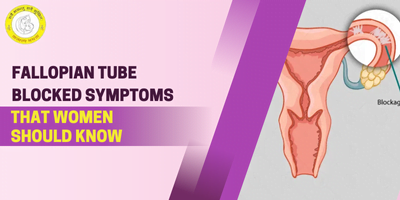Blocked Fallopian Tubes Symptoms Every Woman Should Know

Think about the joy of wanting to become a mother but then experiencing the heartache of infertility. For many women, blocked fallopian tubes symptoms are the cause of this struggle. These important tubes help move eggs from the ovaries to the uterus.
In this Article
When they’re blocked, sperm can’t reach the egg, making it hard to get pregnant. Knowing the blocked fallopian tubes symptoms can lead to early diagnosis and treatment, giving hope to those trying to conceive. This blog post will go over the blocked fallopian tubes symptoms, their causes, and the treatments.
What Are Blocked Fallopian Tubes?
A basic understanding of fallopian tubes combined with their functions helps us understand Blocked Fallopian Tubes. The fallopian tubes play an essential role in fertility by transporting eggs between the ovaries and the uterus. A blocked fallopian tube stops an egg from moving through the tube.
The blockage that could cause infertility results from Endometriosis and Pelvic inflammatory disease (PID) as well as previous surgical procedures afflicting one or both tubes. Detection of early Fallopian Tube Blockage requires immediate attention to receive appropriate medical treatment.
6 Critical Blocked Fallopian Tubes Symptoms
Here below are some key symptoms to watch for when dealing with blocked fallopian tubes:
1. Pelvic Pain
A common sign of blocked fallopian tubes is persistent pelvic pain, usually on one side. This pain might be confused with menstrual cramps or ovulation pain. If the pain is ongoing and gets worse during your period, it could be due to a blockage.
2. Pain During Intercourse
Experiencing pain during sex, especially deep in the pelvis, can be a symptom of blocked fallopian tubes. This pain might be due to conditions like endometriosis or PID that can lead to blockages.
3. Irregular Menstrual Cycles
Women with blocked fallopian tubes might notice their periods are irregular. This can be related to other conditions like endometriosis or pelvic inflammatory disease (PID), which can also cause blockages.
4. Infertility
Trouble getting pregnant after trying for a while is a major sign of blocked fallopian tubes. Since these tubes are crucial for the egg and sperm to meet, blockages can make natural conception difficult.
5. Painful Periods
If your periods are unusually painful and last longer than normal cramps, it might be a sign of blocked fallopian tubes. This kind of pain often points to problems with your reproductive organs.
6. Ectopic Pregnancy
Blocked fallopian tubes can sometimes lead to an ectopic pregnancy, where the fertilized egg implants outside the uterus, often in a fallopian tube. This is a serious condition and can cause sharp pelvic pain, vaginal bleeding, and dizziness.
What Causes Blocked Fallopian Tubes? Common Risk Factors
Blocked fallopian tubes can be caused by various conditions and can greatly affect a woman’s ability to conceive. Common causes of blocked fallopian tubes include pelvic inflammatory disease (PID), which results in scarring and damage from infection.
Endometriosis, a condition where tissue similar to the uterine lining grows outside the uterus, can also lead to blockages. Additionally, past surgeries in the pelvic area may create scar tissue that contributes to tubal obstructions.
Additional risks include genital TB, which can seriously damage the fallopian tubes, and tubal ligations, which are meant to prevent pregnancy but may unintentionally cause blockages. Early diagnosis and treatment are crucial to manage and prevent these blockages effectively.
Effective Treatments for Blocked Fallopian Tubes
Blocked Fallopian Tubes can make it difficult for sperm and eggs to meet, posing a significant challenge for women trying to get pregnant. Here’s an overview of some treatment options to help with this condition:
1. In Vitro Fertilization (IVF)
For severe blockages or cases that don’t respond to surgery, IVF is an option. It involves fertilizing the egg outside the body and then implanting the embryo directly into the uterus, bypassing the fallopian tubes.
2. Medications for Infections
If an infection is causing the blockage, antibiotics can help treat it and reduce inflammation. However, they might not reverse any existing damage or scarring.
3. Salpingectomy
This surgery removes one or both fallopian tubes, usually when there’s severe damage or infection. It can also be done to remove cysts that are blocking the tubes.
4. Laparoscopic Surgery
This minimally invasive surgery uses a small camera (laparoscope) Laparoscopic Surgery to look inside the pelvic area and remove blockages or scar tissue from the fallopian tubes.
5. Fimbrioplasty
This surgery repairs the fimbriae, the tiny projections at the end of the fallopian tubes that help in guiding the egg. It’s used when these projections are damaged or blocked.
6. Tubal Cannulation
In this procedure, a catheter is used to clear blockages in the fallopian tubes. It’s often done during a hysterosalpingography (HSG test ), where a dye is injected into the uterus and tubes to spot any blockages. If a blockage is found, the catheter helps to open the tube.
7. Salpingostomy
This procedure creates an opening in the fallopian tube to bypass a blockage, especially when there is a fluid-filled tube that needs to be drained.
Conclusion
Understanding the Blocked Fallopian Tubes Symptoms and treatment options can help women seeking to conceive. Early recognition of symptoms and timely medical intervention can improve the chances of overcoming infertility. Whether through surgical options like laparoscopic surgery and tubal cannulation, or assisted reproductive technologies like IVF, there are several ways to address Fallopian Tube Blocked Symptoms and achieve a successful pregnancy.
If you have any issue related to fallopian tube and pregnancy, you connect to Diwya Vatsalya Mamta IVF Center in Patna for affordable cost and high success rate
FAQs
How to check fallopian tube blockage?
An X-ray examination called hysterosalpingography, or HSG, determines whether the fallopian tubes are blocked and highlights the internal structure of the uterus. A tiny tube is inserted through the cervix and vagina in HSG. The uterus is injected with a material called contrast material.
What will happen if the fallopian tube is blocked?
Infertility may result from blocked fallopian tubes because they prevent eggs from passing from the ovaries to the uterus. If the egg implants outside of the uterus, it may increase the chance of an ectopic pregnancy.
Can blocked fallopian tubes clear on their own?
Making specific lifestyle and dietary changes might improve female fertility, but there is limited scientific evidence that natural treatments can effectively address blocked fallopian tubes. The notable exception is manual pelvic physical therapy, which has shown some success in certain cases.
Can ultrasound detect fallopian tube blockage?
Fallopian tube blockage cannot be detected by ultrasound on its own. While it can be utilized to evaluate surrounding structures, it cannot directly visualize tubal consistency; instead, an HSG or SHG is required.



